
Atiratra Somayag 2015
Background
In 1999 a plot of land was acquired by Fivefold Path Mission on the north bank of the Narmada River about 4 kilometers east of Maheshwar. This is the site of the Homa Therapy Goshala (goshala means cow refuge). At the instigation of Shree Vasant Paranjpe, preparations were begun in 2007 for conducting a series of seven Maha Somayags at the Goshala. The seven Somayags are:
- AGNISHTOMA–for the atmosphere
- ATYAGNISHTOMA–for water
- JYOTI RUKTHA–for food
- SHODASHI–for health
- ATIRATRA–longevity of life
- APTORYAM–well-being, prosperity of the whole society
- VAJAPAYEE–peace of mind
The first of the seven took place at the end of December, 2007. Since then 5 more have been performed there. The sixth Somayag in the series took place from February 3rd-8th, 2015.
What is Somayag?
The ancient science of bio-energy given through Vedas describes certain energy processes which have the power to effect a change in the functioning of PRANA (life-force which pulsates through us and connects us with the cosmos). These energy processes come under the category of YAJNYA. Somayag is one such Yajnya.
AGNIHOTRA, tuned to the biorhythm of sunrise/sunset is the basic YAJNYA which any person can perform with only a little effort. There are Yajnyas to be done at the juncture of two seasons when there is a climate change. There are medicinal Yajnyas (HOMAS).
There are some special Yajnyas to be performed based on astronomic conditions. Somayag (Soma Yajnya) is one such special Yajnya. This lasts for six days. An intelligent young person would take about twelve years to learn this technique with proper Mantra chanting. The person has to follow strict disciplines. This Yajnya is called Somayag because Soma juice is used as the main oblation. Soma is called the king of medicinal herbs. This special Yajnya provides an extra powerful boost of healing energy for the whole world.
The beneficial effect of each of these HOMAS lasts for several decades. The atmosphere becomes medicinal, nutritious and disease-free. Somayags yield a qualitative and quantitative improvement in the psyche.
Following is a brief sketch of each day’s events at the 2015 Somayag. Somayag is a complex ritual, involving a team of 16 Rutviks. Each has his own responsibilities and will chant from one of the four Vedas. Together, all four Vedas will be represented. A number of different processes and tasks are often going on simultaneously. These notes will highlight some of them.

Day 1
The Somayag opens with a ceremony in which Abhay Paranjpe of Fivefold Path Mission, on behalf of everyone from East and West, asks Dikshit Achal Apte to perform the Somayag. This is also about affirmation and intention. Achal agrees, and then there is an energetic clearing of the space in the Somayag shala by the placing of coconuts at the 12 directions (north, northeast, northwest, etc.)
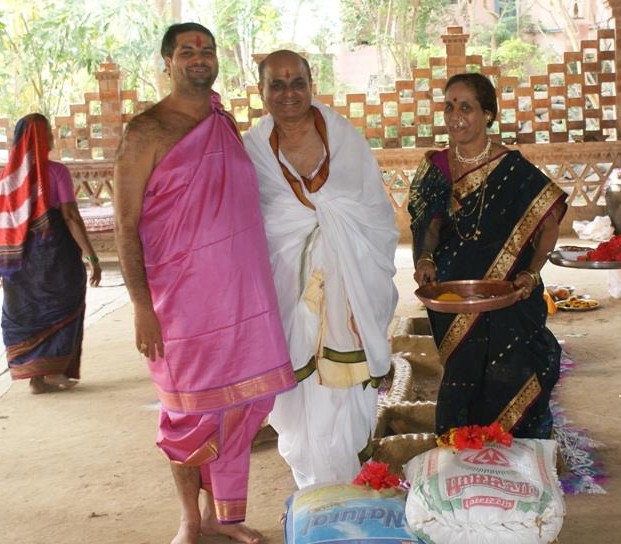


Next comes a bit of play-acting, in which Achal assigns a family member to go “house to house” to find the proper persons to perform the Somayag. In old days, someone would actually have done this; during this Somayag, it was symbolically recreated as one pundit went to all the different Rutviks while they were already sitting in the Somayag Shala next to the Tretagni fire.
Once the team is assembled, fire must be churned, using special wooden instruments, before offerings to fire can begin. Whatever is offered has to be prepared in the Somayag shala, and must be purified by mantras before being offered to fire.
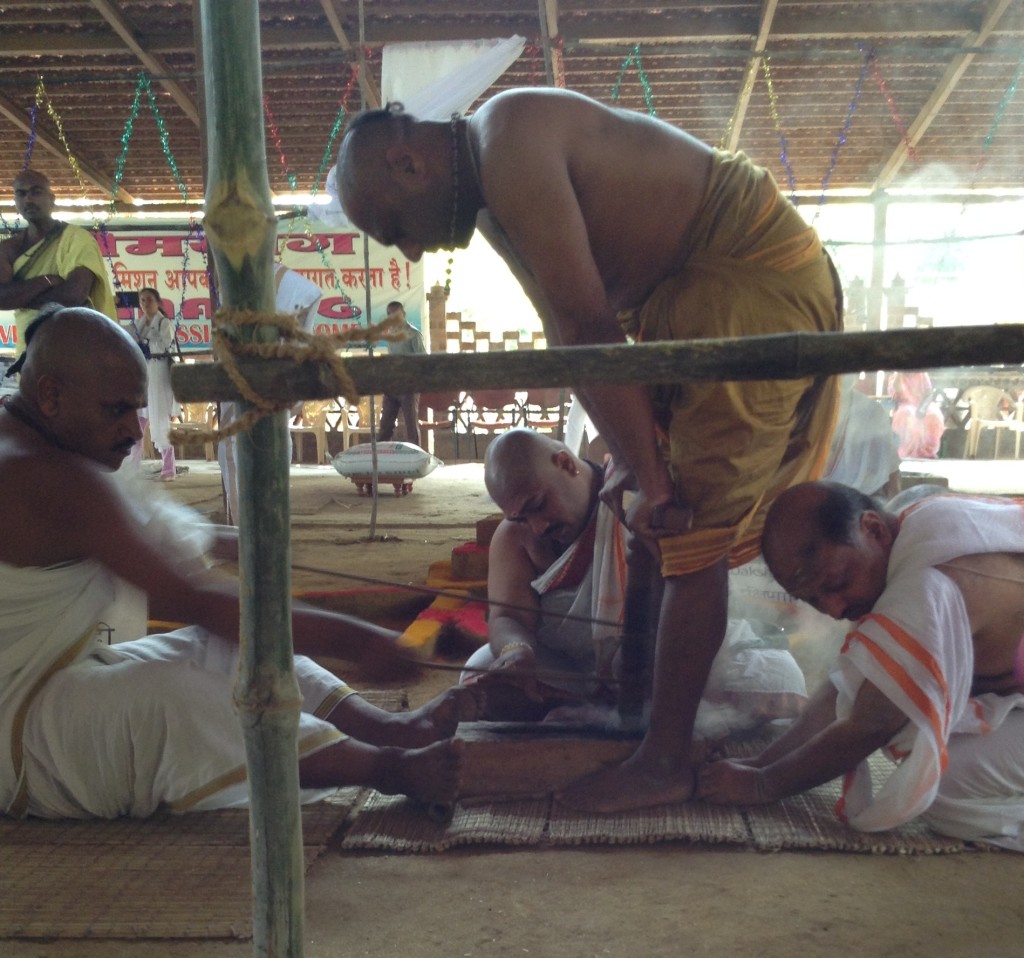
Day 2
On the second day, rice cooked with milk is offered to fire.
Another little theatrical scene is played on this day, in which the Yajaman tries to buy Soma from a seller. The seller asks for more and more money until finally the Yajaman takes the Soma and “beats” the seller for asking money for something that is to benefit the whole world. Then the audience joins in a procession around the shala to welcome the Soma. An Ishti (type of fire ceremony) is done to invite the honored Soma guest into the house. Then fire has to be churned again.
After another Ishti, all 16 Rutviks dip their ring finger in ghee and pledge to complete the Somayag peacefully and with cooperation.
To keep the Soma fresh and full of energy, at intervals each of the 16 Rutviks will, one by one, stand by the Soma while holding a piece of gold in his hand and will pour water over it, with Mantra, watering the Soma.
Pravargyas also begin on this day. First, the implements for Pravargya must be purified. An earthen pot designed with three steps is filled with ghee and is brought to a boil. Then Mantras from all four Vedas are chanted, then a mixture of cow’s milk and goat’s milk is offered, poured onto the boiling ghee. This causes a flame to shoot up, sometimes as high as 30 feet in the air.
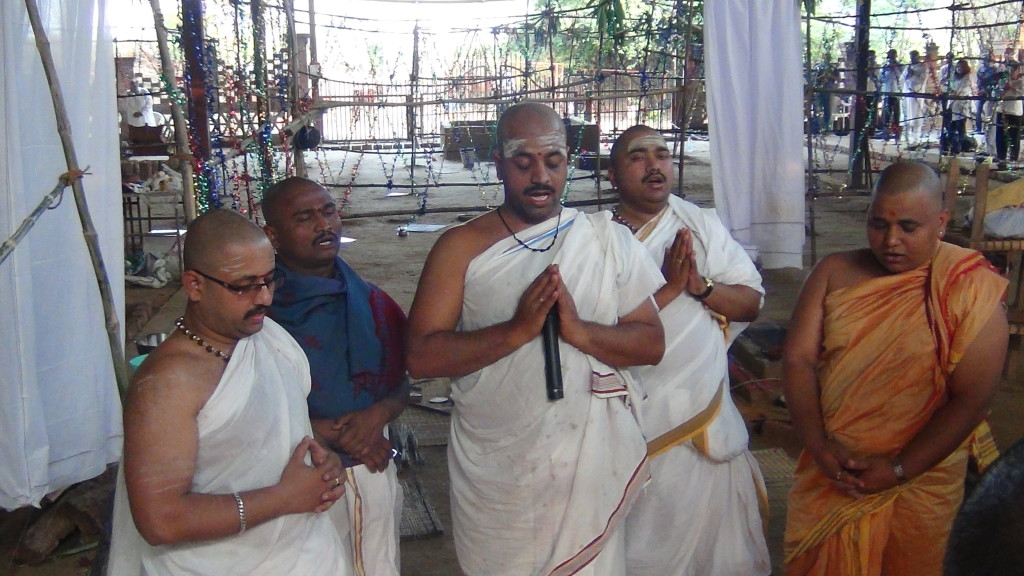

Day 3
Pravargyas continue on this day, along with quiet Mantas and the freshening of the Soma twice daily.

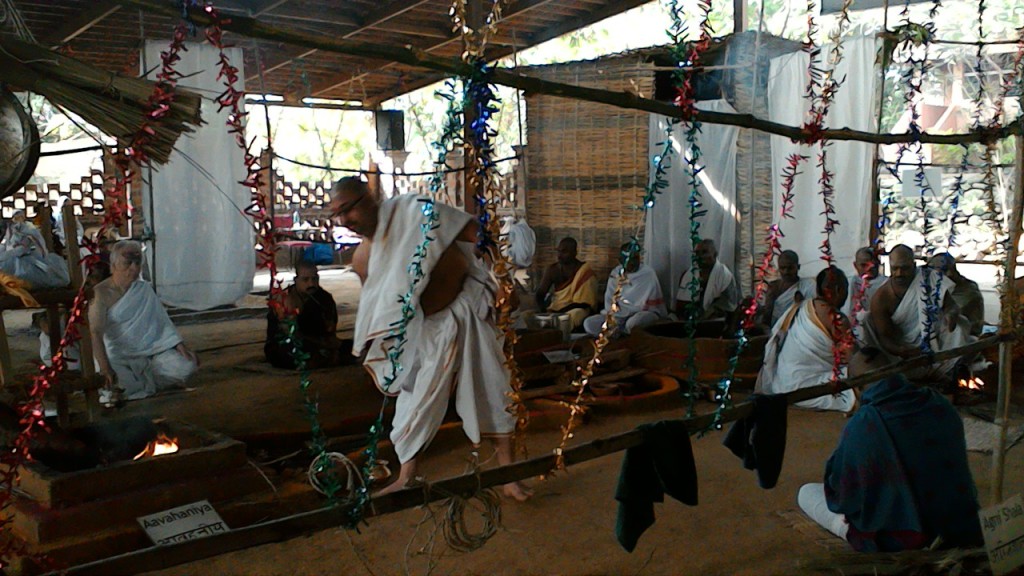

During the Somayag, the group moves through various parts of the Somayag site. On this day, using wooden tools, the Rutviks symbolically clean and prepare the space for Mahavedi, to make the land suitable for Somayag. A column, made from the trunk of an audumbar tree, will be prepared today, for installation in front of the Uttarvedi tomorrow.

In old days, the Rutviks had to prepare everything—build the hut, clear the forest, make clay pots etc. Due to time constraints, a few shortcuts are taken (such as using prepared clay pots), but every step, even symbolically enacted, must be done with Mantra.
Apart from the Somayag, an international music program was held in the evening, featuring performers from a variety of countries.
Day 4
Pravargyas continue. Everything used for Pravargya has power, and should not fall into bad hands. Therefore, afterwards all is offered into Uttarvedi.
Throughout the Somayag, many people gather in the Somayag shala at sunrise and sunset for group Agnihotra. To do Agnihotra with people from all over the world, with so many pyramids ablaze, is a joyous and sacred experience.


The afternoon session begins with a procession, moving into the Mahavedi, under a cloth canopy. They also call it “going from Earth to Heaven”. Then the audumbar post is installed, and again fire has to be churned. Many offerings are made into the Uttarvedi.

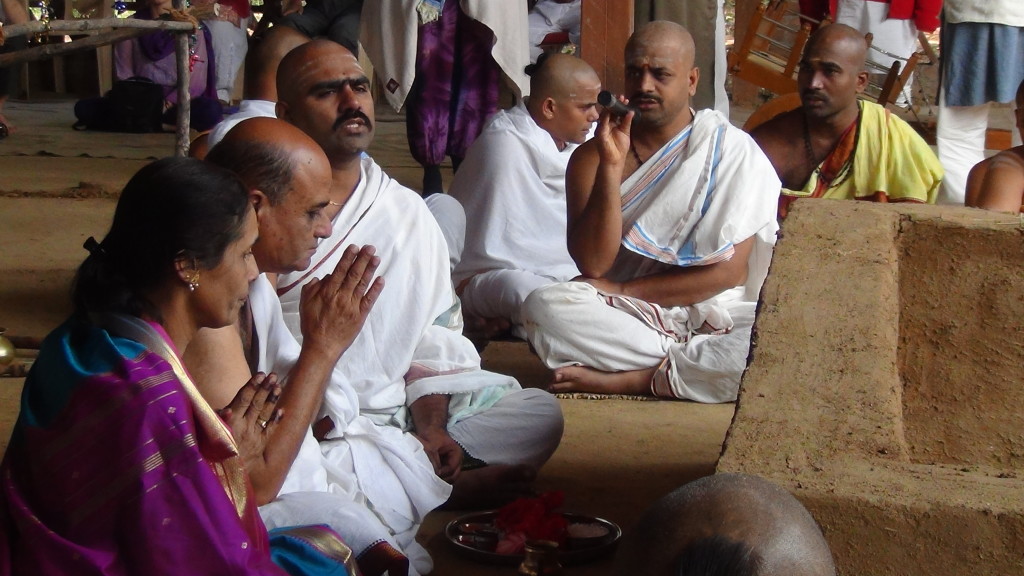
Day 5
The program began at 6 A.M., with offerings into the Uttarvedi. At one point in the morning session, the Rutviks formed a line and, reaching to connect to each other, did a little “snake dance.” Later in the morning fire again was churned, and more offerings were made into the Uttarvedi.
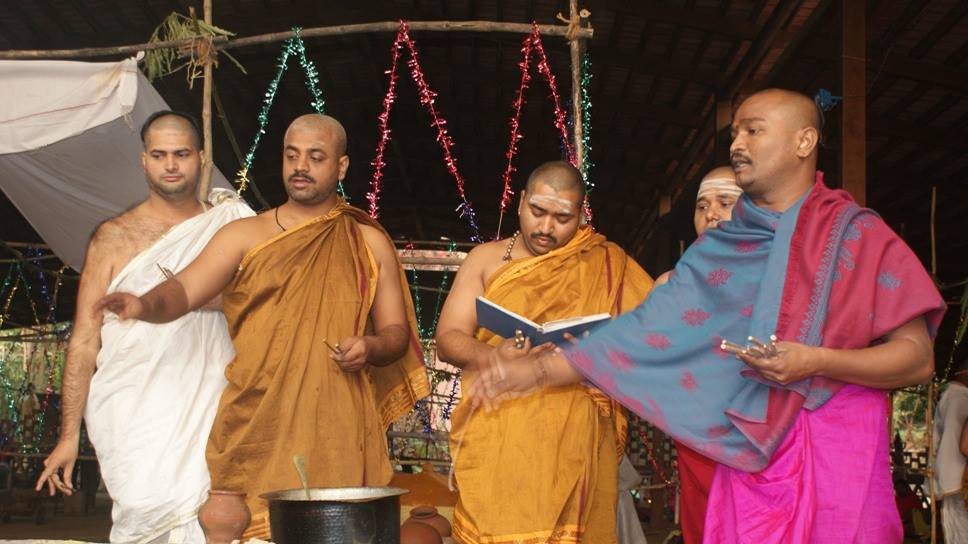
On this day, one by one, everyone has the opportunity to help pound the Soma, using a mortar and pestle. Later in the day, offerings of Soma begin. At one point in the evening, a horse is brought into the shala.
The sessions go on until about 1:30 A.M. One has to marvel at the endurance of the Rutviks, chanting for so many hours in a day.
Day 6
This session starts at 4 A.M., just a short time after the last one ended, in which the Rutviks chant, without break, 1,000 Mantras. Quite a feat!
This day is a sort of “wrapping up” of the proceedings. The Rutviks make offerings to atone for any mistakes they may have made in carrying out their duties in the Somayag. After that, the final offerings are made.
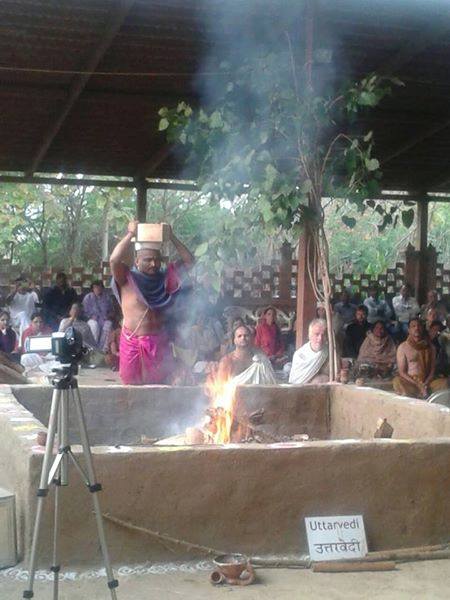
In late morning, a procession forms, heading down to the river. This is a joyous occasion, celebrating the successful completion of the Somayag. The procession halts for a while at the amphitheater, for drumming and dancing.


Then the group continues on to the Narmada. The Rutviks chant some mantras, and various implements used in the Somayag are thrown into the river. After submersion, those materials used for Somayag, such as cups, bowls etc., might be kept as souvenirs, but must never be used in any ritual. When the items are submerged, the power they carry goes into the river. Then we all wade into the Narmada for bath, splashing, laughing and shivering, as the energy of the Narmada lifts our spirits and calls us HOME.
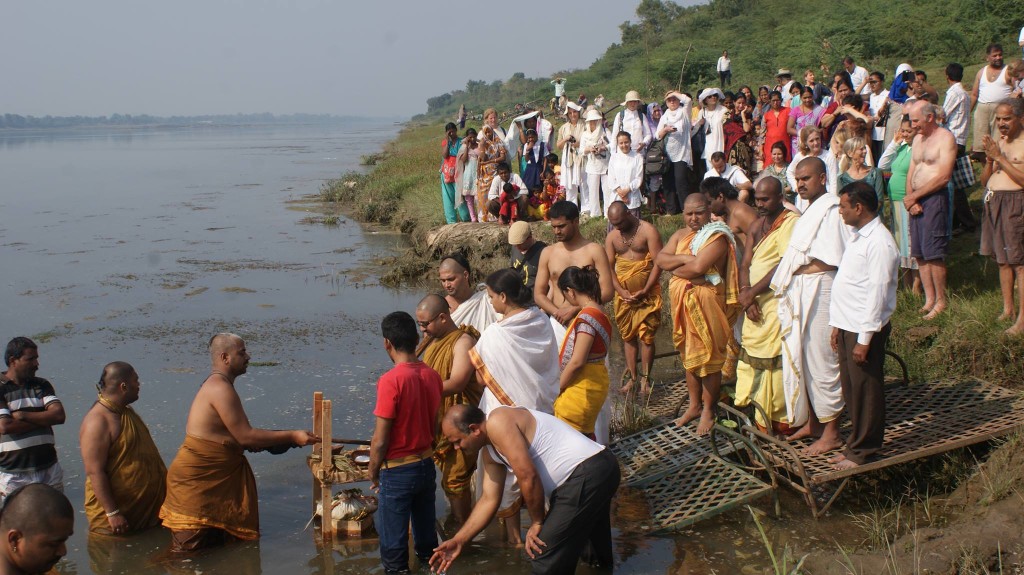

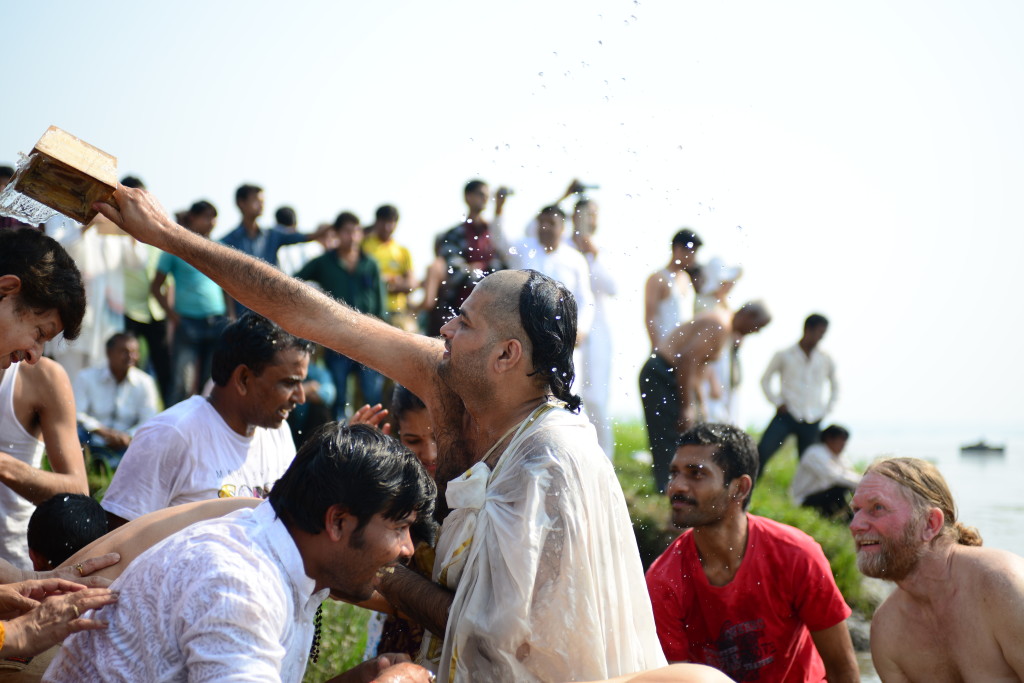
To see video clips of the Somayag, visit somayag.org. Below the video screen, click on “watch the video archive on Ustream.” To the right of the screen, use the slider bar to select the video clip you want to view.
Thanks to the following people for their photo contributions:,Shreedhar Thanedar for #s 1, 2, 3, 16, 17, 19, 20 and 21; Patricia Norton for #s 4, 14 and 18; David Fields for #s 5, 7 and 8; Thomas Hirt for #s 10, 13 and 21; and Luz Vargas for #12.
